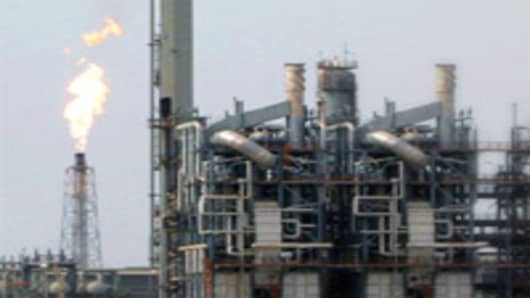The volatility switch has flipped in the energy sector, creating opportunities for investors ready to buy at increasingly attractive entry points.
With gasoline approaching $4 a gallon at the pump, and crude oil$100-plus a barrel, most U.S. investors would be wise to hedge that rise with an overweight position in energy.
Jeff Saut, chief investment strategist at Raymond James, has been overweight energy for most of the last decade and says higher prices are here to stay.
“There is some geopolitical premium to the current higher prices,’’ Saut says. “But the era of cheap oil is in the rearview mirror.”
The energy sector of the S&P 500 is up 14 percent year-to-date through March 22 but down 1.4 percent for the month while the S&P 500 overall is up just 3 percent and down 2.6 percent in March.
While the rise resembles what happened to the sector during the spike in oil prices to $147 per barrel in 2008, Saut says increased global demand is driving the current rally as opposed to the speculative forces at work three years ago.
He points to the rise of a consumer middle class in China and other developing markets, as long-term sources of global consumption of oil and other commodities.
“When per capita income rises, people consume more,’’ says Saut, who sees oil prices settling at higher plateaus due to stronger global demand.
The short-term outlook for energy is less settled.
The nuclear catastrophe in Japan and ongoing unrest in the petroleum-rich Middle Eastand North Africa are driving global commodity prices and short-term demand for oil, natural gas and coal. But Tim Parker, portfolio manager of the T. Rowe Price New Era Fund , cautions against drawing conclusions too quickly.
Instead, Parker says the Japan situation could unfold similarly to what happened with theBP oil spill. Japan should be a short-term negative for oil as demand pulls back but a long-term positive as the world’s third largest economy taps other fuel sources to replace displaced nuclear capacity.
“You couldn’t have sold BP fast enough but you had a month to figure out what to buy,’’ Parker says. “You could see the same thing in Japan, with good opportunities in the coming weeks.’’
Parker is keeping an eye on several subsectors including oil producers like Continental Resources and Cameron International as well as oil services firms like SchlumbergerandHalliburton .
Japan is the world’s largest consumer of liquefied natural gas, which could be a boon for stocks like Range Resources and Southwestern Energy . The island nation is also a big user of coal and could lift producer stocks Peabody Energy and Arch Coal .
Rather than pick individual stocks, investors can gain diversified or concentrated exposure to the energy sector through dozens of mutual funds and ETFs.
Funds like T. Rowe Price New Era maintain lower volatility than the average energy fund by owning stocks in both the energy and natural resources sectors, which Parker says behave slightly differently. The fund also invests a third of its assets in international stocks.
Another no-load energy fund to consider is Invesco Energy , which maintains very low turnover of its mostly domestic holdings and currently favors oil services stocks.
For more concentrated albeit even riskier exposure through mutual funds, Fidelity Select Energy Servicesinvests exclusively in stocks that provide equipment and services to oil, gas, and other energy companies, while Fidelity Select Natural Gas invests in stocks influenced by the price of natural gas.
Energy ETFs Appeal to Traders
Mutual funds are well suited for investors with longer time horizons, but those looking to quickly profit from swings in energy prices should take a look at the growing field of ETFs. These low-cost portfolios target sectors like index funds, but like stocks, they can be traded throughout the day and sold short.
Three of the top ten selling ETFs in February targeted the energy sector: the Energy Select SPDR was No. 1 and is up over 10 percent this year compared to a gain of less than 2 percent for the S&P 500. Oil Services HOLDRsand SPDR S&P Oil & Gas Exploration & Production were also top sellers.
Vanguard Energy ETF is also a good proxy for the energy sector and holds four times as many stocks as XLE, according to Matt Hougan, president of ETF Analytics.
ETFs also offer international exposure to energy —something not as readily available on the fund side — through iShares MSCI ACWI ex US Energy Index , which includes stocks in emerging markets of Russia, China and Brazil, andSPDR S&P International Energy Sector, which only taps developed markets. iShares S&P Global Energycovers the United States and international developed energy sectors.
Another set of exotic ETFs that have gained prominence since the natural disasters in Japan are Market Vectors Uranium & Nuclear and Global X Uranium , which invest in producers and suppliers of nuclear energy. Both portfolios hold less than two dozen stocks each, raising their risk profile considerably. NLR lost about 19 percent and URA dropped nearly 30 percent in the week following damage to the Fukushima Daiichi plant.
The renewed reliance on coal can be followed through Market Vectors Coal , which invests globally including a one-third weighting in emerging markets.
Wind Blowing In for Alternatives
And don’t forget the clean energy movement.
Robert Wilder, who maintains the Wilder Hill Clean Energy Index, says the events in Japan have caused solar and wind stocks to surge. But perhaps more importantly, a movement away from nuclear energy and geopolitical threats in the oil patch are causing many nations to revisit their commitment to clean energy.
“A number of countries have been taking away subsidies for clean,’’ Wilder says. “Now even countries lacking money for subsidies are talking about not pulling back so much.”
Wilder says changes in energy policies should have more of a positive impact effect on wind stocks, which generate significantly more power than solar.
Investors can tap the green energy trend through the PowerShares Wilder Hill Clean Energy ETF, which mostly invests in U.S. stocks,Market Vectors Global Alternative Energy andPowerShares Global Clean Energy ETF .



